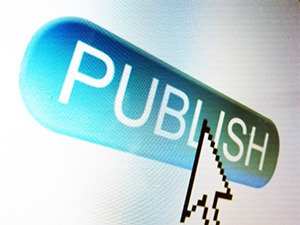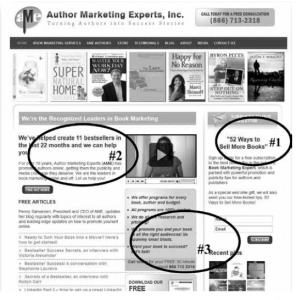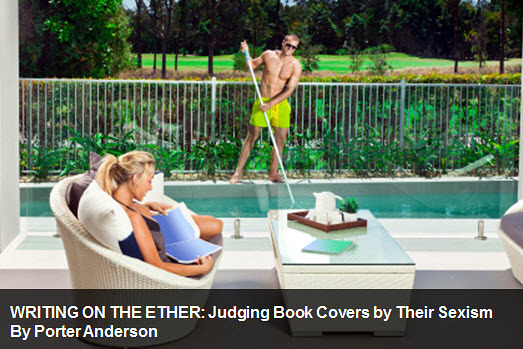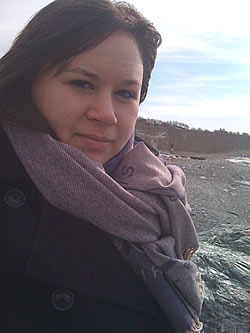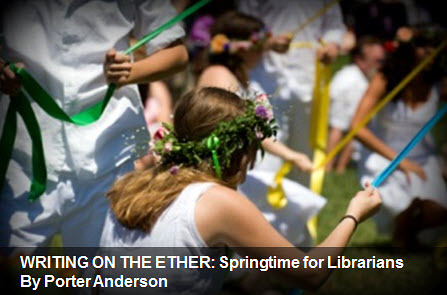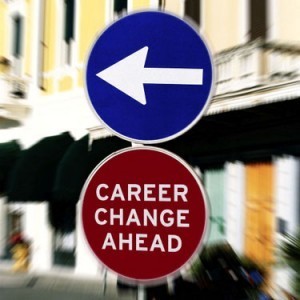Jane Friedman's Blog: Jane Friedman, page 177
May 22, 2013
Submission: 6 Rules of Thumb From an Editor-Turned-Writer
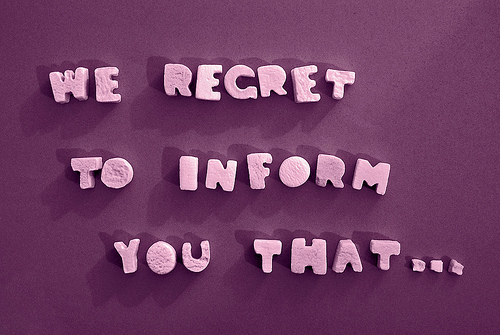
Photo by Caro Wallis / Flickr
Today’s guest post is by writer and editor Jennifer Niesslein (@jniesslein), who is based in Charlottesville, Virginia.
I’m experiencing karma.
For more than a decade, I co-edited a literary magazine—I was the person who wouldn’t respond regarding your writing for three months, sometimes longer. And now, for the past nine months, I’ve been writing.
It truly does feel like submission.
My years as an editor most definitely influence my submission process and how I interact with editors. I can’t say my tactics have gotten my work published more often, but they reduce some of the gut-wrenching anxiety. Here are my rules of thumb.
I submit to publications I like.
I don’t submit to any publication that I haven’t read thoroughly, and enjoyed at least 75% of its content. On a basic level, this is a smarter way to submit than to pepper editors far and wide with work that may or may not be a good fit. I want to get published, not grow a collection of rejection notices. I also want my work to be published alongside work I admire.
A few years ago, I saw that a writer was publicly criticizing my magazine on Facebook, yet still wanted to write for us. Her criticisms weren’t sweeping, such as pointing out a lack of gender or racial diversity; I’d leveled those at other publications myself. Instead, they were little nitpicky things that showed she didn’t respect our editorial choices and wanted us to run the show differently. Someone on the thread who knew us as open-minded people suggested that she pitch us something. And I thought, “Oh, please do not.”
This is what I would have told her (if I thought it wouldn’t come off as mean-spirited): If you already think you could do a better job choosing content, chances are excellent you’ll think you can do a better job editing. The whole process will be frustrating on both ends, a fight at every comma. Art may be long, baby, but life is short.
After an editor rejects three pieces of my work, I move on.
I have an unusual name (last name, anyway), and I know that when I was on the other side of the desk, it took pretty much three times for me to start associating a name with writing I didn’t want for my magazine.
There’s one publication in particular that I would love to be published in; many of my writer friends are published there, and the site is part of my daily read. But I’ve sent three different essays and received a form rejection for each. (Two of these essays have since run elsewhere in places I’m thrilled to be in.) I suspect that “Jennifer Niesslein,” for that editor, is synonymous with “no, thank you.” Worse, now that I’m associated with unwanted writing, the bar has been raised from Pretty Damn Good to This Has to Blow My Motherfucking Mind.
There is enough rejection in the world. I’m not setting myself up for more.
I try to be easy to work with.
I try to remember to do all the things that made me want to work with a writer again. I turn in fully cooked work that represents the best that I’ve been able to manage on my own. I use whatever system the editor prefers to look at drafts (track-changes in Word, Google Drive, etc.). Most importantly, I understand that we share a common goal: to get the piece in the absolute best shape it can be in before publication.
Editing is often thankless work. The pay usually sucks (if it pays at all), and all the glory goes to the writer. Most, if not all, editors are in it because they love great writing and want to be part of a team that disseminates it to people who share that love. There probably are bad editors out there, just as there are bad plumbers and bad doctors and bad rodeo clowns. But I don’t encounter those bad editors because I only submit to publications that I admire.
It’s pretty much a cliché at this point that it’s only the writers most in need of a good edit who are the most resistant to one. But it’s true. An actual reply I received after e-mailing a round of edits: “Sigh. Sometimes I wish I were a sculptor so when I finish my masterpiece, it’s done.” Yes, and sometimes I wish I were in a time machine so I could snatch that acceptance letter back, but that’s neither here nor there.
Writers and editors both have something at stake: The writer’s name is attached to the piece, and the editor’s name is on the masthead. There is nothing so lovely as forming a post-publication mutual admiration society.
I recognize what control I have.
The only real power a writer has in the editor/writer relationship is the power to withdraw the piece. That’s it.
Most of the time, though, it shouldn’t have to come to that. When an editor tells me something is wrong with an essay I’ve written, her fix might not be the one I prefer—but it does need a fix. I’ve become a better writer both my listening to what editors tell me and by editing some fine work.
It’s not personal.
Everybody says that, but seriously, it’s not. Editors are rejecting your work, not you.
And there are about a million reasons work gets rejected. The biggest is that the quality isn’t up to snuff, but some reasons have absolutely nothing to do with the quality. I have rejected work because we ran something on the same topic one or two issues ago; the essay is really more of an op-ed; we were already committed to a number of essays on emotionally dark subjects; the writing was fine, but the piece lacked a fresh take on the subject; the story being told seemed unfinished; the opinions were expressed condescendingly to the reader; the short story’s first-person point of view wouldn’t work in a magazine composed mostly of personal essays; we just had some other contenders that we liked more. I could go on.
Please re-read the above paragraph whenever you need some salve. You might also try a meditation CD or a nice drink.
I think carefully about endings.
A surprising number of writers flub the ending, so I try very hard to land on just where I should.
When I read submissions, this is how I knew we had a keeper: Interesting opening, middle that gave me a lot to chew on, and an ending that knocked my socks off. If the ending fizzled out, all that momentum the writer built into my reading experience suddenly slowed.
I clearly remember reading a draft of an essay last year that nailed it, and when I got to the end, I immediately went to the Google doc that the three editors shared and typed next to the writer’s name, “I don’t know how she did this, but I love it. Accept.”
And I think that’s the mystery of the whole process. I can offer you as many nuts and bolts as I think are helpful, but really, it boils down to this little bit of alchemy:
Write so that you make someone say, “I don’t know how she did this, but I love it.”
The post Submission: 6 Rules of Thumb From an Editor-Turned-Writer appeared first on Jane Friedman.
May 20, 2013
Infographic: 5 Key Book Publishing Paths
One of the biggest questions for authors today is:
Should I traditionally publish or self-publish?
It’s an important question—one that tends to result in heated debate—but it’s becoming an increasingly confusing and complicated question to answer because:
There are now many varieties of traditional publishing and self-publishing—with evolving models and varying contracts.
You won’t find a universal, agreed-upon definition of what it means to “traditionally publish” or “self-publish.”
It’s not an either/or proposition. You can do both. (See this interview with CJ Lyons.)
I spend a lot of time at writers conferences trying to clarify the pros and cons among the different publishing paths and the growing number of services available to authors. There is no one path or service that’s right for everyone; you must understand and study the changing landscape and make a choice based on long-term career goals, as well as the unique qualities of your work—not to mention your own strengths and weaknesses.
With that in mind, I’ve developed an infographic (click to download as PDF) to describe what I see as the key 5 publishing paths, their value to authors, the potential pitfalls, and examples of each. These five paths are:
Traditional publishing: where you query and submit to agents and editors in an effort to land a contract that pays an advance and royalties (and typically involves nationwide bookstore distribution).
Partnership publishing: one might consider this the evolution of traditional publishing, where authors are positioned more as partners, receive higher royalties, but usually no advance.
Fully-assisted publishing: the old “vanity” self-publishing model, where you write a check and get your book published without lifting a finger. I don’t recommend this, but it’s still a significant part of the self-publishing market, now dominated by Author Solutions.
Do-it-yourself (DIY) publishing with a distributor: while this applies to either print or e-books, today this usually involves e-publishing your work (to reduce financial risk and investment involved with print), and using a service provider or distributor to reach all possible online retailers—and/or to provide some level of assistance.
Do-it-yourself (DIY) direct publishing: when an author doesn’t put any middlemen between him and the retailer selling his books. Often, this option is combined with #4 above; for example, someone might sell direct through Amazon KDP, and complement it with distribution to all other retailers through Smashwords. This is possible because most distributors and online retailers of e-books work on a nonexclusive basis.
What about an agent’s role in these five models? Generally speaking, agents should serve as an author’s career manager and adviser, not as the author’s publisher. This is why I’ve included agent-assisted models in “special cases” below the chart. Still, though, when it comes to partnership publishing, agent-run outfits (e.g., Rogue Reader) are doing some of the most innovative work, and this only blurs the lines further.
You’ll notice I’ve indicated that, moving from left to right across the chart, an author gains more control over the process, undertakes more risk, and stands to earn more money. This is a generalization and may not hold true in every situation. For fully-assisted publishing in particular, one might argue this poses the highest risk and offers the least control. However, as a general rule, keep in mind that as one moves from the traditional models to DIY models, the author undertakes more risk, work, and responsibility, but stands to gain more financially if successful over the long term.
Feel free to download, print, and share this infograph wherever you like. I will keep developing it as the publishing landscape changes, so leave a comment if you have suggestions for how to make it more helpful.
For more information on getting published, visit these popular posts:
Start Here: How to Get Your Book Published
Start Here: How to Write a Book Proposal
How Long Should You Keep Trying to Get Published?
How to Publish an E-Book: Resources for Authors
10 Questions to Ask Before Committing to Any E-Publishing Service
Looking for more? Check my Writing Advice Archive.
The post Infographic: 5 Key Book Publishing Paths appeared first on Jane Friedman.
May 17, 2013
Should You Self-Publish? 15 Questions
Today’s guest post is by Orna Ross (@OrnaRoss), director of the Alliance of Independent Authors.
Self-publishing is not for every writer. In order to succeed, you need to have or develop specific traits, along with certain ways of approaching the publication of a book. Consider the following questions.
1. Are you positive and proactive?
Many writers wait for permission from an agent or publisher to say they are fit for publication—or for a PR campaign to explain why somebody should buy their book. The flip side of this passivity is chronic complaint syndrome: writers moaning about the vagaries of agents or publishers, about the death of bookstores, the dominance of Amazon, etc.
Not independent authors. You must take responsibility for the risks, as well as the rewards, of publishing your own work.
2. Are you brave?
Risk is the core activity of self-publishing. You must risk time on ideas, promotions, or concepts that may come to naught. You must risk money to pay for editorial and design upfront. You must also risk, in some circles, reputation. Family, friends, and many others may see self-publishing as a second-best option. Independent authors must put themselves out there twice over, once in the writing, again in the publishing.
3. Are you hardworking?
If there’s one quality that all successful independent authors have in common, this is it. You must be full of energy and commitment, not only to your writing but to educating yourself about all aspects of craft, editing, design, and promotion. You must recognize opportunities and make the most of them, without derailing your writing, the engine of it all.
4. Are you entrepreneurial?
Independent authors who do best have an entrepreneurial mindset. You must always be on the lookout for new ways to reach readers, new communities who might be interested in your books, new opportunities to get your message out. You should be a savvy user of social media and know how to engage resources like e-mail lists, newsletters, promotions, competitions, and book giveaways to extend your readership. You must be open to failure and willing to learn from mistakes, while excited by the prospect of new projects and creative collaborations.
5. Are you resilient?
Successful self-publishers, by definition, are those who have kept on keeping on, adapting where necessary, and following their hearts. Mark McGuinness says in his new book, Resilience: Facing Down Rejection and Criticism on the Road to Success, in going indie, you must ensure you haven’t exchanged traditional forms of rejection and criticism for others that can be just as painful and costly. “Anyone who says, ‘Don’t take it so personally’ doesn’t understand what it’s like when you are hit by a major rejection or biting criticism,” says Mark. “Successful indies have found ways to acknowledge the pain—and bounce back from the impact.”
6. Do you base decisions on research?
You must follow gut feelings and intuitions, yes, but successful self-published authors generally back such horse sense with researched facts and figures to stay smart, sharp, and up to date—to search out their readers, stay in touch with influencers in their field, and give their books an advantage. Whether it’s keyword research, marketing studies, direct mail tests or just dear old Professor Google, you should enjoy learning, growing, and getting it right.
7. Do you have good financial sense?
Successful self-publishers don’t tend to be the kind of writers who say, “I don’t care about money,” unless they have a benefactor or obliging day job. Controlling costs is important for all businesses, and you must be able to take care of your resources and make sure you spend money where it will produce the biggest effect.
8. Are you collaborative and supportive?
That literary communities can be a tad, shall we say, bitchy, is well known—but the camaraderie between successful self-published authors is outstanding. Indies are likely to work from the co-opetition model, where competitors cooperate for mutual benefit.
Answering yes so far? Good—you’re half way there. With those personality traits in place, it is necessary to work them in a certain way in order to succeed in self-publishing.
9. Have you tried to find an agent or publisher?
Yes, great books can fail to make it through the gatekeeping process, especially books that are literary, or unusual, or in genres that the industry does not perceive as selling well. On the other hand, many books fail to find an agent or publisher because the writing isn’t ready for publication. The process of trying to get through the gates—taking the rejection, learning and applying the lessons, mastering your craft over time—is often a necessary one, if you want to get real about what’s involved in putting together a book worth reading.
10. Have you made a plan for copyediting, formatting, cover design, and ISBNs?
There’s more to making a book than writing it. Have you taken on board all the functions you will need to master if you are to successfully self-publish? They are all very much learn-by-doing activities, but you need to be realistic about the time and energy commitment.
11. Have you thought about your team?
Just because it’s called self-publishing doesn’t mean you’ll do everything yourself. You will need to draw on the services of some or all of the following: critique groups, beta readers, designers, editors, formatters, and promotional services. Have you at least begun to research how you will approach your workflow, and who you will use to deliver the services you need?
12. Do you understand your niche?
Niche markets addressing special interests are often seen as too unprofitable to be of interest to trade publishing. These overlooked niches is where many indie authors prosper. Even if you’re not that niche, to succeed as an indie you need to go where your readers are, which means understanding your place within the reading ecosystem.
13. Do you know who your reader is?
Some authors become self-publishers because they are recognised experts, or to enhance their standing in their field, or to justify an increase in their fees. Some they are committed to a cause, or have a story that just has to be told.
Regardless of your primary motive for writing, you must have a marketer‘s sensibility. You may not use marketing terms, but you will not survive, never mind thrive, if you are not attuned to the needs of your readership or don’t communicate with them. You will need to to go where most of your readers are most likely to be found online, to their forums and blogs, and make it your business to understand their concerns.
14. Do you have a marketing plan—a plan to reach readers?
Book sales happen only if you make them happen. How are you going to make people aware of your book? How will you make them interested? How will you find your audience?
15. Have you made a plan for your next book?
Are you using a self-published book to attract an agent or trade publisher? Or do you want to keep your own rights and grow your own audience, long term? To make the smartest choices possible, you should have a goal or strategy that extends past your first book.
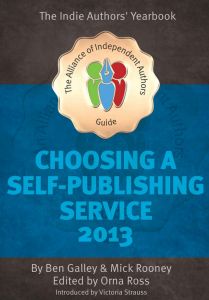 If you’re considering the self-publishing path, then I recommend taking a look at the annual guide from the Alliance of Independent Authors: Choosing a Self-Publishing Service 2013. The guide compares twenty of the most significant publishing services, in terms of price, royalties, and terms. Click here to preview or sample on Amazon.
If you’re considering the self-publishing path, then I recommend taking a look at the annual guide from the Alliance of Independent Authors: Choosing a Self-Publishing Service 2013. The guide compares twenty of the most significant publishing services, in terms of price, royalties, and terms. Click here to preview or sample on Amazon.
The post Should You Self-Publish? 15 Questions appeared first on Jane Friedman.
May 15, 2013
3 Ways to Improve Your Website Design
Today’s guest post is adapted from Red Hot Internet Publicity by Penny Sansevieri.
Between Los Angeles and Las Vegas there’s a stretch of I-15 that’s just barren desert with you, sand, a cactus or two, a few vultures hoping to get lucky, and endless billboards. Most people speed down this stretch of highway as fast as possible, passing billboards at maybe 85 miles an hour. Most of the billboards you see will be fairly simple and easy to read.
If you think of your website as a billboard instead of a website, you’ll be much further along than most people. Why? Because at the rate people surf these days, your website might as well be a billboard people glance at while speeding down the interstate. You have only a snippet of time to prove your site is worthy of a visit.
Here are three ways to improve your site design with this in mind.
1. Go light on the copy.
As surfers, we don’t read, we scan. Web copy (the text on your website) isn’t about writing; it’s about writing less. We don’t want to think, we just want to click, and preferably we want to be told what to do. A well-designed site is not just one that’s light on copy; it’s also uncomplicated and very obvious.
2. Don’t clutter the homepage.
When we’re getting a site designed, we have a tendency to want to push everything onto our home page. We cram it full of every piece of everything we’ve ever done. Just like that billboard crammed with stuff, we want to fill every inch of our home page with words and pictures and all the kinds of things—which send surfers scrambling for the exit button. I call it surf shock when you land on a site that seems to scream at you from your monitor.
3. Don’t provide endless choices.
Does your site resemble Starbucks? A million buttons and links with endless choices for the user? Is it intricate and complicated? Unfortunately, while it works well for Starbucks, it won’t work for your site. Giving your user too many options turns into “analysis paralysis,” and they’ll click off faster than you can say, “double tall, non-fat, no-foam latte.”
Whatever you do and whatever your business is, your home page should have only one goal. Whether that’s selling a product, selling a service or selling you, you need to pick one overarching objective for the home page.
What’s your goal? What do you want people to do when they land on your site?
The Most Important Area of Your Site
Numerous studies have been performed about how people surf. As we discussed above, people scan text. They don’t read every word, but look for the most important pieces that will directly benefit them. Remember that it’s all about the WIIFM factor (what’s in it for me?).
In the illustration above, you’ll see three areas of my site numbered, which correspond with their level of importance.
1. This is the most important piece of the home page. The primary goal of your home page should be reflected here. If you want to sell a product, get newsletter sign-ups or any other important activity, this will be a key spot. Why? Because we read from left to right, so when someone lands on your site, they scan landing on the right side first.
2. Once the eye scans #1, it heads right over to the #2 spot with one question in mind: WIIFM? So #2 and #3 must answer that question for them. The headline is the most important part, and the copy should lead with the most important information.
When visitors land on my business page, it is not about the company or the products we have, it’s about visitors and how we can help them navigate the maze of marketing and publicity options. And did you happen to notice the calls to action on the page: Find Out More, Call Now, Download Our Catalog? It’s important to tell people what you want them to do.
Finally, bear in mind that social proof is powerful, which is why we have the row of books at the top of the page and the reference to bestsellers in the copy.
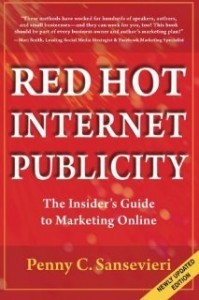 If you enjoyed this post, then take a look at Red Hot Internet Publicity by Penny Sansevieri. It’s a terrific primer on online marketing for any author getting ready to launch a book marketing campaign.
If you enjoyed this post, then take a look at Red Hot Internet Publicity by Penny Sansevieri. It’s a terrific primer on online marketing for any author getting ready to launch a book marketing campaign.
The post 3 Ways to Improve Your Website Design appeared first on Jane Friedman.
May 14, 2013
To Be Great, Strive to Be Ordinary
The following guest post from Elizabeth Sims is adapted from her newest book, You’ve Got a Book in You, from Writer’s Digest.
As you plunge into writing your book, here’s the main thing to do:
Strive for the ordinary. Because that’s what the greats do.
If I were a person who used vulgarities, I would say, “You are shitting me.”
I am so not shitting you.
Do not even strive for near-greatness. Look, do you think that every time Joe DiMaggio stepped into the batter’s box he strove to make the most perfect swing in all of baseball? No, he strove to hit the ball.
Do you think that every time Picasso picked up a paintbrush he scrunched up his face and said to himself, “OK, boy, whatever you do, don’t blow it. Don’t ruin this canvas. What you’ve got to do is try really hard to produce another triumph that will make the art world sob with emotion.”
Right.
Picasso probably didn’t say anything to himself, he dove into that canvas with a child’s bright, open anticipation.
Do you suppose that every time Shakespeare or Jane Austen or Virginia Woolf, Henry David Thoreau, J.D. Salinger, Martin Luther King, Jr., F. Scott Fitzgerald, Winston Churchill, Dorothy Parker, Charles Dickens, or Isaac Asimov sharpened their quill or uncapped their Parker Duofold or clicked their Bic or sat down to their massive gorgeous loud clunky Underwood, they thought, “Ah! Now to unveil brilliance to the world!”
They sat down merely expecting themselves to relax and write.
So, then: I want you to behave just as the greatest geniuses behaved. I want you to strive to write an average book. A decent book. An OK book. In order to do this, you must first write an average sentence. And you have to start somewhere. And that is no sweat.
“The funicular car bucked once more and then stopped.”
That is the first sentence of Ernest Hemingway’s short story “Cross-Country Snow.” It’s fashionable to bash Hemingway these days (mostly in the form of scoffing at his machismo), but whatever you think of him, you have to love that sentence. A whole writing lesson lies in it: There’s the lesson of beginning a story by writing a simple, declarative sentence, and there’s the lesson of where to start your story.
Whenever I get to feeling anxious about the writing I’m doing, I remember, “The funicular car bucked once more and then stopped.” In fact, if you pick up my second novel, Damn Straight, you’ll notice that I sort of ripped off the structure of Hemingway’s sentence for my first sentence:
The power struggled back up for about ten seconds—ten brown little seconds—then failed again.
You don’t have to start at any obvious beginning, no matter whether you’re at sentence one or in the middle of Chapter Fifty. Get right going.
Unleashing Your True Voice
Another aspect of being ordinary—and being yourself as a writer—is unleashing your own voice.
What does that really mean?
Voice. English teachers talk about it; writing teachers talk about it. Agents and editors talk about it.
Professional authors never talk about it. We just write the best we know how. Voice is simply your style of writing, your way of expressing yourself. Authors write in different styles, we know this. Ernest Hemingway wrote blunt and punchy, for example, while Virginia Woolf wrote smooth and delicate.
Readers love a unique, authentic-sounding voice. Agents and editors hunt assiduously for original voices.
Your voice as a writer is the words you choose, the rhythm you use, the colors and inflections that characterize you.
No one kind of voice is better than another. All you want to do is be yourself. Like everything else good in writing, a free, unique voice stems from flow: from you, the writer, being in harmony with your world and your material.
How to Kill Your Voice and Disappoint Your Readers
Overthink your writing.
Be extremely careful; that is, try to write totally grammatically, as if the world’s meanest teacher were looking over your shoulder.
Try to write as if you’re smarter or dumber than you are.
When you want to show that you’re being casual, write down the first cliché that comes to mind.
When in doubt, get tight.
How do you write with your own original voice? Stay in touch with your heartbrain, and write it how you’d say it.
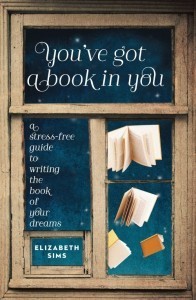 If you enjoyed this post, I highly recommend Elizabeth Sims’ You’ve Got a Book in You. It’s perfect for writers about to tackle their first manuscript or writing project. Click here to get a sample from Amazon.
If you enjoyed this post, I highly recommend Elizabeth Sims’ You’ve Got a Book in You. It’s perfect for writers about to tackle their first manuscript or writing project. Click here to get a sample from Amazon.
The post To Be Great, Strive to Be Ordinary appeared first on Jane Friedman.
May 9, 2013
WRITING ON THE ETHER: Judging Book Covers by Their Sexism
Table of Contents
Ether En-Gendered
Judging Book Covers by Their Sexism
A Game of Thrones, reinterpreted by Electric Sheep Comix
Stardust, Reinterpreted by Librarian Monica Fumarolo
Throne of Glass, Reinterpreted by Ardawling
Franzen’s Freedom, Reinterpreted by Book Revels
A Clockwork Orange, Reinterpreted by “Brandy”
Lord of the Flies, Reinterpreted by BGM
And Claire Messud: No Reinterpretation Needed
Ether En-Gendered
I proposed a little experiment on Twitter. I asked people to take a well-known book, then to imagine the author of that book was of the opposite gender, or was gender-queer, and imagine what that cover might look like. Because we have these expectations in our heads already.

Maureen Johnson
And author Maureen Johnson’s “little experiment” helps me seed our cloud of weekly single-issue Ether here on Thursdays at JaneFriedman.com with a cluster of topics I want to focus on from time to time in coming months.
I want to tell you about it here first and see if I can get some outlines on a legendarily unweildy subject. Then we’ll have some structure. Maybe.
I’m thinking Ether En-Gendered because to “engender” means, primarily, “to produce by a union of the sexes.”
Literature—of absolutely all types, just turn off your genre head for a moment, please—should be en-gendered (not un-gendered, quit snarling), engendered as a thing of both male and female impulse and availability.
My hetero-life-partner @ is the fucking man.
[image error]May 7, 2013 10:15 pm via webReplyRetweetFavorite
Alex Wilhelm
Yes, some writings may be created mainly for men or mainly for women, nothing wrong with that.
But in the aggregate, the overall compendium, the uber pile of pages and pixels, the idea of literature, of books, should be the first art we expect to escape the scourge of gender discrimination.
YES! BRING US SCIENCE! “@ #coverflip has put me in the mood for some SCIENCE! Shall I run an experiment on this topic?”
[image error]about 17 hours ago via webReplyRetweetFavorite
maureenjohnson
In purest form, literature:
Is working in words, not pictures (as in visual art, for example, or ballet or modern dance, or film);
Is accomplished in the stir and stretch of a reader’s imagination, not in Dolby sound (as in vocal music and its sexually charged seat in our popular culture today); and
Is housed in the mind, both of the author and of the reader (not in the marble realm of sculptural majesty or the granite might of architecture).
Because our stories ride the ethers of each other’s guesses and dreams, you’d think we’d have got ’round those flesh-and-blood traps set for other art forms.
Tomorrow I am having a sequel to last night’s launch party, in York @ . Like all sequels it will be darker, and edgier.
[image error]May 8, 2013 3:41 am via Twitter for BlackBerry®ReplyRetweetFavorite
Matt Haig
But we’ve long known we were failing on this. We’ve known that literature wasn’t escaping that surly bond of our fixation on the gender divides. As in so many things, we’ve turned away from the gaze-direct at the problem, and let it flicker off on the side, as inconsequential as that boilerplate that tells us any resemblance to real persons, living or dead, is purely coincidental…
You never believed that, did you? Well, of course you didn’t.
Check out @‘s gender-flipped covers, in case u need even more proof of gender inequality in publishing. http://t.co/Lk9YOVD9cS
[image error]May 7, 2013 4:40 pm via webReplyRetweetFavorite
Jodi Picoult

Edward Nawotka
In January, for example, Edward Nawotka, Editor-in-Chief at Publishing Perspectives, my host-site for Ether for Authors on Mondays, gave us It’s Time Publishing Tries Something Radical To Entice Readers.
In it, Nawotka asked, in essence, if all of us in publishing wouldn’t run, not walk, if we could woo 47 percent of Americans who don’t routinely buy books.
Oddly, we didn’t run. We didn’t even walk. Know why? Because the biggest part of that target crowd is men.
Nawotka:
Perhaps it’s time for the publishing community to do something radical to entice new readers. I don’t know what that might be, but I might suggest that we start with something specifically targeted at men. My guess is that an overwhelming number of that 47% is male and it seems like a sensible proposition to target the most obvious group we know who don’t regularly buy books and read.
OverDrive and Sourcebooks to Launch Ebook Data Experiment http://t.co/caOc8njeJq Can only be interesting. Hats off to @ @
[image error]about 2 hours ago via Tweet ButtonReplyRetweetFavorite
Stephen Page
Mind you, as Nawotka pointed out, you can always find a glimmer of hope on the horizon, something promising, an inch taken where a mile is needed.
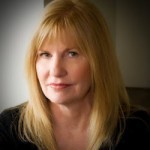
Darrelyn Saloom
Darrelyn Saloom, Ether sponsor (My Call to the Ring with Deirdre Gogarty) was one of only three readers to drop a comment on Nawotka’s post, but it’s a good one:
Southern Living has done it by adding author and Alabama native Rick Bragg to write a monthly column for the magazine. I attended two of his events this year in South Louisiana, and burly, oil-field men were there and saying how much they look forward to reading every new issue of Southern Living.
Just as an aside, Nawotka is also a member of a men’s reading group in Houston. It’s named, with unassailable accuracy, the Men’s Book Club. Guess how long they’ve been at it? Sixteen years. And in Texas. I throw no stone, I’m a South Carolinian.
But don’t tell me “men won’t read,” I’m sick of hearing that, and you should be, too.
Lunch in the garden. I’ll read there. What book to choose. This could take a while. Probably Elizabeth Bishop. My recent bedtime friend.
[image error]about 2 hours ago via Twitter for AndroidReplyRetweetFavorite
Michael Crossan

Eoin Purcell
Just this week, I was tweeting with Eoin Purcell, our good colleague in Dublin, about the fine set of MOS’s about e-reading (“man on the street” comments in broadcast-speak) that precede an interview show he did on UK ebook adoption. It’s the RTE Media Show from .
The last voice we hear talking about e-reading in that pre-interview tape is a man who says he likes reading on the train with an e-reader because it’s:
More private, people don’t know what you’re reading.
Tuck that away for now. It’s an important clue, I believe, to the difference in how men and women read today. It may have to do with why we’re told that men are reading so much less than women (or won’t read fiction, or won’t talk about their reading, or won’t read anything without an explosion in each chapter, etc.).
No BEA, I’m not on Instagram and seriously, why are you asking me?
[image error]about 17 hours ago via TweetDeckReplyRetweetFavorite
Don Linn
For now, it’s enough to establish one shapely leg of the Ether En-Gendered conversation we’ll visit from time to time. Let’s summarize its issues:
Are Men Not Reading? Who Told Us That? Is It True? How Can We Get More of Them Doing It? And What Subtle Signals Does the Industry Deploy In Its Presentation of Books To Men?
Relax, we won’t go to that one today. It’s one of my faves, but we have another topic, thanks to Johnson and her associates at Huffington Post Books.
@huffpostbooks @maureenjohnson Here’s the cover I mocked up for my book. My publisher was like um thx. twitter.com/andrewtshaffer…
— Andrew Shaffer (@andrewtshaffer) March 20, 2013
That part of this ongoing discussion, we’ll encapsulate as:
How Do Women Fare Both As Writers and Readers? What Subtle Signals Does the Industry Deploy to Skew Our Perceptions of Women’s Writing? And Is There a Chance That Women Unwittingly Could Be Helping To Hinder Men Reading?

Jane Friedman
Here, my other Ether-eal host, for the original Writing on the Ether, Jane Friedman, is standing by to offer you a grand compendium of literature-themed articles on women and feminism, in her role as digital editor to Virginia Quarterly Journal. Her array of online writings paralleling the Autumn 2012 edition of the journal (on feminism, “The Female Conscience”) is rich with insights and provocative viewpoints.
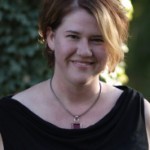
Jennifer Niesslein
There’s the down-to-earth near-cinematic progression of scenes in Notes on One’s Self-Identity by author Jennifer Niesslein:
Heads or tails, mothers or not, we’re doing our best to create a rewarding personal life in a culture that’s overly concerned with maternity, and we’re trying to create a professional legacy in a culture that’s biased against women—and might still be after we’re both long dead.
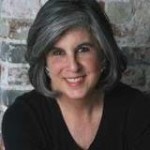
Hallie Ephron
And there’s a pretty intriguing look at News Obituaries: Another Gender Gap from novelist Hallie Ephron, who writes:
Though women live on average five years longer than men, it’s no secret that their death rates are identical. One hundred percent, male or female, all of us die. So, if there were equal opportunity in news obituaries as there is in paid death notices, there should be an equal number of women and men whose lives get written up in the newspaper. But it’s far from equal—at least that’s been my impression reading The Boston Globe.
@colleenlindsayQuit calling my friend a fat chick. You are huggable. *scary mom-eyes* — Julie Butcher (@Julie_Butcher) May 9, 2013
Regular Ether readers will be glad to know we’re not headed for another round of “Where Are the Men at Writing Conferences?” In this long spring of conference-going, I’ve actually seen a better gender balance among attendees than in the past at major writing events.
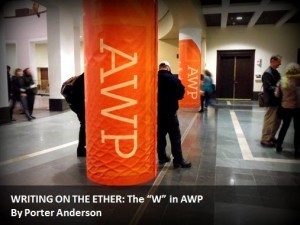 Is I wrote here, the Association of Writers and Writing Programs (AWP), God bless its gigantic heart, seemed awfully light on sessions themed with men’s interests, but the crowd, itself in a snowy-slushy-freezing Boston, was a real good mix, approaching parity, I’d say.
Is I wrote here, the Association of Writers and Writing Programs (AWP), God bless its gigantic heart, seemed awfully light on sessions themed with men’s interests, but the crowd, itself in a snowy-slushy-freezing Boston, was a real good mix, approaching parity, I’d say.
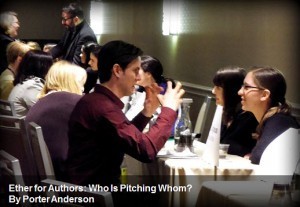 At Writer’s Digest Conference East in New York, there was what looked like a far better blend of men and women in attendance this year than we’ve seen there in past years, maybe as many as 40 percent of the crowd male and highly active in Q&A, etc. (not always the case for guys at confabs).
At Writer’s Digest Conference East in New York, there was what looked like a far better blend of men and women in attendance this year than we’ve seen there in past years, maybe as many as 40 percent of the crowd male and highly active in Q&A, etc. (not always the case for guys at confabs).
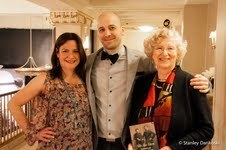 And in this past weekend’s much balmier Boston than AWP encountered in March, Grub Street’s big The Muse and The Marketplace conference had a gratifying representation of men in the seats, I’d say about a third, which is especially good on a regional platform.
And in this past weekend’s much balmier Boston than AWP encountered in March, Grub Street’s big The Muse and The Marketplace conference had a gratifying representation of men in the seats, I’d say about a third, which is especially good on a regional platform.
So we’ll let that irritating conference-attendees subject rest for now, the blue buses and the pink buses are parking in more of the same lots, and I call that progress. Today, let’s pick up on the element of En-Gendered Ether that Johnson has provided: What Subtle Signals Does the Industry Engage to Skew Our Perceptions of Women’s Writing?
I’m saying this in the back of a cab on my way to another work obligation. Lately, all I do in cabs is catch up on personal emails. & tweet.
[image error]May 7, 2013 7:14 pm via SeesmicReplyRetweetFavorite
Ginger Clark
Judging Book Covers by Their Sexism
Shirtless Men Kissing Beautiful Women. How long have I been going on about these romance covers that choke the ebook lists? The trend is somewhere from merely tedious to outright infuriating for all but the millions of romance consumers and the folks feeding that frenzy. (More power to you—the fact that I’d like to see what I hash as #legitlit in sway isn’t your problem. You keep those guys shirtless as long as the ride lasts. I’m just trying to get pants onto the literary team.) Where Johnson takes us this week is in the nearby neighborhood of that ubiquitous cover smooch. https://twitter.com/Laura_Jennings/st... In The Gender Coverup at Huffington Post Books, she does a thoroughgoing job of hitting the inequities now all but indigenous in the world of books—particularly their presentation to young minds (she writes YA).
So, we’re thinking about boys and girls and what they read. The assumption, as I understand it, is that females are flexible and accepting creatures who can read absolutely anything. We’re like acrobats. We can tie our legs over our heads…Boys, on the other hand, are much more delicately balanced. To ask them to read “girl” stories (whatever those might be) will cause the whole venture to fall apart. They are finely tuned, like Formula One cars, which require preheated fluids and warmed tires in order to operate.
It’s a good article, I hope you’ll read it all.
Maybe this idea that there are “girl books” and “boy books” and “chick lit” and “whatever is the guy equivalent of chick lit” gives credit to absolutely no one, especially not the boys who will happily read stories by women, about women. As a lover of books and someone who supports readers and writers of both sexes, I would love a world in which books are freed from some of these constraints.
Where she’s leading, and where we’re going, is that experiment she mentioned.
@erinwert @maureenjohnson I’m not sure if you’re talking about nursing or Seahorse hangouts. — Alice Rourke (@Smooshie1592) May 9, 2013
What she asked people to do was to reinterpret how the covers of known books might go if those books’ authors were, “of the opposite gender, or was gender-queer.” Cool results. And it’s the heart of our focus today.
We’re told not to judge books by [their covers], but… EVERYBODY DOES. That is what they are for. They are the packages that get your attention, that give you messages about what to expect.
https://twitter.com/sam_hubble/status... The Post’s team put some of these reinterpretations into a gallery with books’ original covers, in Coverflip: Maureen Johnson Calls For An End To Gendered Book Covers With An Amazing Challenge. I want to take a few of them in pairs, side by side, for comparison. One of the few drawbacks of online galleries is that we tend to bomb through them as fast as our clicks can carry us, and it might be hard to get some nuance at such a clip. In some cases, responding cover designers (re-designers?) changed the author names to help put across the concept.
Back to Table of Contents
“Agility isn’t always about doing the new stuff, the cool stuff, the meme-worthy, and the rest.” David Smith http://t.co/17PF4nDy7t #toccon
[image error]about 2 hours ago via HootSuiteReplyRetweetFavorite
Guy L. Gonzalez
A Game of Thrones, reinterpreted by Electric Sheep Comix
We have the original cover for George R.R. Martin’s A Game of Thrones in the Book 1 (A Song of Ice and Fire) paperback edition from Bantam, and we have Electric Sheep Comix’s (Patrick Sean Farley) reinterpretation.
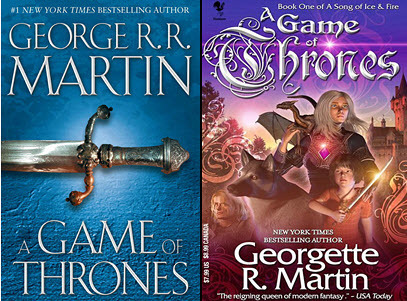
From Huffington Post Books, an original cover for A Game of Thrones, left, and a reinterpretation by Electric Sheep Comix
In the reinterpretation, you’ll notice that Martin has become not only Georgette (and a one-R. Martin, not two) but also “The Reigning Queen of modern fantasy.” From Johnson, on the exercise as a whole, not just in terms of this book’s real and reimagined covers:
The simple fact of the matter is, if you are a female author, you are much more likely to get the package that suggests the book is of a lower perceived quality.
Do you agree with that?
Back to Table of Contents
@maureenjohnson Eish! no words… — SHIRLEY JENNER (@SHIRLEYJENNER1) May 9, 2013
Stardust, Reinterpreted by Librarian Monica Fumarolo
At her site, Monica Fumarolo writes:
This is my play on Stardust by Neil Gaiman. Had a woman written it, I feel like the romance side of things would have been played up much more than the action/adventure aspects.
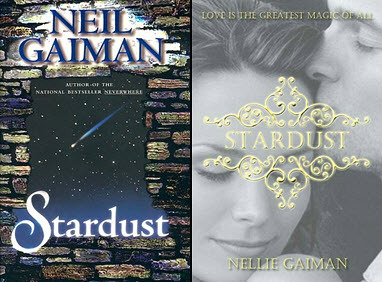
From Huffington Post Books, the first UK edition cover for Neil Gaiman’s Stardust , left, and a reinterpretation by Monica Fumarolo
As you can see, in this instance, Mr. Amanda Palmer has become “Nellie Gaiman” for a new play on the Stardust cover. I’d say Fumarolo might only want to take out that bit of the guy’s collar in the lower right corner. We like our Men Shirtless when Kissing Beautiful Women, you know.
La influència del gènere de l’autor en el disseny de la coberta… una notícia curiosa. http://t.co/EhyYqtHhmk
[image error]about 8 hours ago via webReplyRetweetFavorite
Ricard Peris
Throne of Glass, Reinterpreted by Ardawling
We’re going the other direction in this one, the hardback cover from the Bloomsbury USA release Throne of Glass, reinterpreted by self-described “graphic hobbyist” Ardawling. Be sure to get “throne” into your next title, right? Ironically, author Sarah J. Maas does tweet as @SJMaas, the masculine-ized name Ardawling gives her on the reinterpreted cover. And even more ironically—as panelists at the Grub Street the Muse and the Marketplace conference this weekend discussed—this thing of women writing under initials has become so prevalent that it’s almost always a sign of a female author, not male.
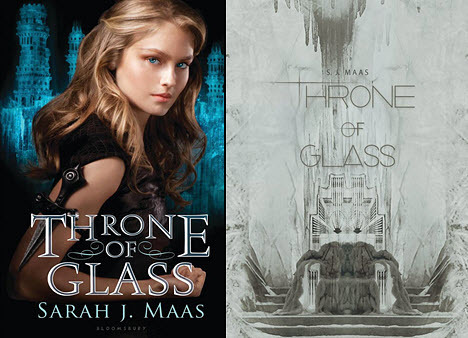
From Huffington Post Books, the Bloomsbury USA hardcover for Sarah J. Maas’ Throne of Glass, left, and a reinterpretation by Ardawling
Looking at the brittle, Deco-structural interpretation Ardawling produces brings Maureen Johnson’s comments to mind:
If we [women] sell more — and we often don’t — it is simply because we produce candy, and who doesn’t like candy? We’re the high fructose corn syrup of literature, even when our products are the same. It’s okay to sell the girls as long as we have some men to provide protein.
That pretty handily predicts the next one.
@porter_anderson Duh — Victoria Noe (@Victoria_Noe) May 8, 2013
Franzen’s Freedom, Reinterpreted by Book Revels
Book Revels is a site for “young adult books and pop culture ramblings” from “Ellie”—who describes herself as “a twenty-something librarian completely obsessed with YA literature.” She gives us what Johnson calls “the soft-sell cover with the warm glow and the feeling of smooth jazz blowing off of it.” Which, especially on a title like Jonathan Franzen’s Freedom from Farrar, Straus & Giroux, easily reminds us, in the reinterpretation, of the “feminine products” advertising context, no?
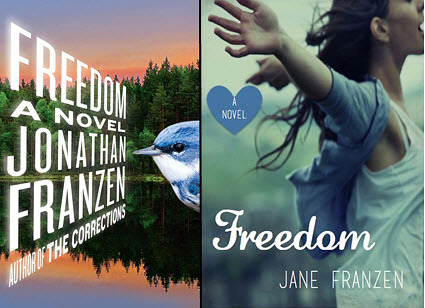
From Huffington Post Books, the FSG original cover for Jonathan Franzen’s Freedom, left, reinterpreted by Book Revels
About her reinterpretation, “Ellie” at Book Revels writes:
Here’s my take on Freedom by Jonathan Franzen as if it were written by a female author. I went with an image of a girl whose entire face you can’t see with a blurred background (i.e. the typical YA cover). I also chose a cursive font, which I see a lot of on “girl” books.
I am seriously getting that ‘City of Shirtless Simon’ Tshirt. @
[image error]about 10 hours ago via webReplyRetweetFavorite
Pamela Pena
A Clockwork Orange, Reinterpreted by “Brandy”
Anthony Burgess becomes Antonia, and we go from the 50th-anniversary Norton hardcover artwork to a conspicuously stylish reinterpretation by “Brandy.”
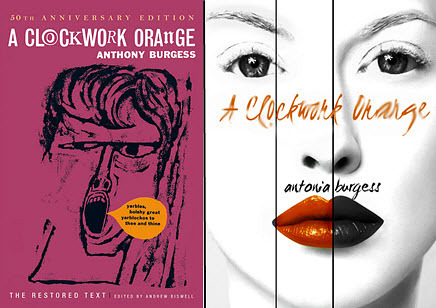
From Huffington Post Books, the W.W. Norton hardcover anniversary artwork for Anthony Burgess’ A Clockwork Orange, left, and “Brandy’s’ reinterpretation
“Brandy” writes about her reinterpretation:
I did the coverflip. I tried my best… hopefully it reflects both the challenge and the themes of the book, A Clockwork Orange, as written by Anthony Burgess. All in all, Maureen’s a genius.
One more.
@genniferalbin #coverflip not just abt reader appeal. Abt valuing female authors,their expertise & their content. @vida_lit @maureenjohnson — Anna Boll (@annawritedraw) May 8, 2013
Lord of the Flies, Reinterpreted by BGM
This is the original UK cover for William Golding’s classic, then a reinterpretation by Toronto’s BGM. (Just as an unrelated observation, it’s interesting to see how many folks still don’t identify themselves online, even at their sites and on Twitter. They use pseudonyms, first names only, etc. Happily, we don’t have to work on that one today. It’s just worth noting that even as we encourage authors to identify themselves fully and use their names and faces as IDs, handles and avatars for best networking, an awful lot of Netizens do nothing of the sort.)
[image error]
From Huffington Post Books, the UK cover for William Golding’s Lord of the Flies, left, and a reinterpretation by “BGM”
I love what happens here to Lord of the Flies as the author name switches to Willa Golding and this nurturing, protective evocation of the eternal victim, poor bespectacled Piggy. There are more covers and reinterpretations in the gallery, which is well worth a bit of your time.
Meanwhile, could a reporter please get going on the story of women writers explicitly rejecting “likable?” Wolitzer, Shriver, Messud. Go!
[image error]May 1, 2013 8:46 am via webReplyRetweetFavorite
Jennifer Weiner
And Claire Messud: No Reinterpretation Needed
I’d be remiss in getting out of this edition of the Ether without mentioning the nicely pointed commentary from author Claire Messud in her short interview with Annasue McCleave Wilson at Publishers Weekly, An Unseemly Emotion: PW Talks with Claire Messud. While this incident didn’t involve subtle (and not so subtle) signals transmitted by cover art, it has sparked plenty of healthy comment and debate. Wilson at PW points out that Messud’s character Nora Eldridge in The Woman Upstairs is “angry, really angry.”
It’s clear the dog didn’t like Boris. MT .@publisherslunch #plnws Visting Claire Messud and James Wood In Cambridge publun.ch/12gkIMF — Paul Bogaards (@paulbogaards) April 24, 2013
Messud’s response invokes Chekhov’s line about not having to defend horse thieves and making a terrific statement about the expectation that women in fiction must not be allowed the harsher emotions male characters are granted. She makes herself perfectly clear on the point while also clarifying that Nora is a complex and rounded character, hardly an emblem of anger:
If it’s unseemly and possibly dangerous for a man to be angry, it’s totally unacceptable for a woman to be angry. I wanted to write a voice that for me, as a reader, had been missing from the chorus: the voice of an angry woman. So yes, Nora Eldridge is middle aged and yes, she is angry. I’m not trying to deliver some “message”—I’m not suggesting that middle age and anger are synonymous, or that being single makes you angry, or anything like that. Nora is an individual, one particular person, whose psyche has been formed by temperament and a series of circumstances. She has just emerged from a long period of suffering, the care for and loss of her mother to a hideous illness. She is trying—like each of us—to do the best she can.
And the interview gets even better when Wilson asks Messud, “I wouldn’t want to be friends with Nora, would you? Her outlook is almost unbearably grim.”
As if friendship potential is the criterion for a proper character.
Messud’s “For heaven’s sake, what kind of question is that?” response has been repeated and celebrated for the past week. Part of Messud’s response:
If you’re reading to find friends, you’re in deep trouble. We read to find life, in all its possibilities.
It’s an enlightening exchange, now being reinterpreted, itself, in many ways by folks discussing and sharing it.
So now it’s your turn: Expectations, signals, clues, interpretations, thrown by cover art in particular—how gender-biased can they be? How conscious is the publisher or designer of such bias and message? How aware of this element of bookselling are you on a regular basis? Fill me in, I’m all ears.
Main image: iStockphoto: ep_stock
The post WRITING ON THE ETHER: Judging Book Covers by Their Sexism appeared first on Jane Friedman.
May 6, 2013
How to Be Less Scared of the Blank Page
Many writers struggle with finding the muse, getting in the flow, or beginning a story that’s difficult to tell in the first place.
Ella Mei Yon has some wonderful insights over at the Glimmer Train bulletin. She writes:
The way in is something I’ve always struggled with. To write, I need to enter a whole other state of mind, where time slows down and my perception is sharp on details. Where I’m focused, but open. Where creativity blends with the critical. That state is quite different from the state of mind I need to live the rest of my life—to get things done, make money, socialize.
The solution—if there is one—for Ella Mei Yon? It begins with a list. Click here to read more.
Other offerings this month at Glimmer Train:
Method Writing by Benjamin Percy
On the Joys of Not Finishing What You Started by Michelle Richmond
An Author’s Notes Toward Possible Future Works by Daniel Wallace
Gut. Or Never Knowing the Next Word by Lance Weller
The post How to Be Less Scared of the Blank Page appeared first on Jane Friedman.
May 3, 2013
Best Business Advice for Writers: April 2013
Best Business Advice for Writers is a monthly link round-up where I share the best online articles focused on the business of writing and publishing. Share any best reads you’ve found lately in the comments.
Discover Your Author’s Brand by Philip Martin
If you’re turned off by conversations of author branding, this post is for you. Martin discusses branding as creating a culture of belief, which has these key elements:
Creation story
Creed
Rituals
Icons
Sacred words
Non-believers
Leader
Martin goes on to discuss and deconstruct each element, and what it means for authors. Click here to read the entire post at Blue Zoo Writers.
The Book Marketing Strategy Every Author Must Implement by Robert Smith
What’s the strategy? Giveaways. Smith offers a strong checklist of things you can do to maximize any type of giveaway campaign. Click here to read the entire post at Author Media.
The Ultimate Guide to Making Money With the Amazon Affiliate Program by Darren Rowse (@problogger)
This is a long, long post that I now consider the go-to post for anyone looking to make a little (or a lot) of money through Amazon Affiliate sales. Even if you’re not an affiliate with Amazon, this is worth bookmarking just in case that day should come. Click here to read the entire post at ProBlogger.
How to Sell Your Self-Published Book Into Bookstores by Jason Boog (@jasonboog)
You’ll find a variety of perspectives and resources here, on a topic where it’s especially difficult to find good guidance and instruction. Click here to read the entire post at MediaBistro.
Book As Event by Kristine Kathryn Rusch (@KristineRusch)
An insightful post that distinguishes between books that are significant “events” for the publisher, and those that are not. New authors tend to believe EVERY book is an event, but Rusch will quickly disabuse you of that notion:
Realize this is one gigantic corporation with lots of imprints. Realize that a lot of the people who work on one book in September for one imprint will work on books for other imprints. And also realize that for some of the authors and books listed, these catalogs are the only promotion they will see from their traditional publisher.
Click here to for the full post.
How I Doubled My Traffic by Finding My Audience by Robert Farrington (@BeatThe9to5)
A helpful and specific post for bloggers on how to build traffic to your posts. Click here to read the full post at ThinkTraffic.
The Complete Guide to Setting & Negotiating Freelance Rates by Tom Ewer (@tomewer)
Another one of those mammoth guides that is worth bookmarking and referencing for a long time to come. From the intro:
Setting and negotiating rates can seem like one of the most complicated and intimidating parts of freelancing but it really doesn’t have to be. Today I’m going to give you an in-depth overview of how to set and negotiate rates with prospective and existing clients. Although I’m a freelance writer, I believe that most of the following advice applies to any service-based business.
Click here to read the entire post at LifeHacker.
12 Ideas for E-Mail Updates You’ll Actually Enjoy Writing by Toni the Geek (@duolit)
I’m always advising authors to start e-mail newsletters, but as soon as I do, I’m often asked “What should I put in the newsletter?” Here are some ideas to get you started. Click here to read the full post at DuoLit.
3 SEO Myths That Scare Writers and How You Can Use Them to Your Advantage by Alexis Grant (@alexisgrant)
SEO doesn’t have be confusing. It’s actually quite simple. This is a good place to begin the demystification process. Click here to read the full post at Robert Lee Brewer’s site.
Book Marketing Using Paid Promotion: Targeted E-Mail Lists by Joanna Penn (@thecreativepenn)
Excellent insight into a special form of promotion: e-mail advertising. Joanna first discusses when you might want consider paying for advertising (in general):
It’s worth using paid promotion if:
• You have a book with a great cover and great reviews. The social proof of reviews is critical for people to trust the buy process.
• You can reduce the price easily and quickly for a short period – which means you need access to the ‘back end’ of the publishing process, which generally means it’s open to indie authors only
• You have more than one book, and it’s definitely worth putting the first of the series on special
• You have a budget for promotion, as you may not make back what you spend – results vary.
Joanna then offers up a case study on e-mail advertising from an experiment she ran. Click here to read the entire post at The Creative Penn.
Neal Pollack on Rebounding From Massive Hype and Six-Figure Deals to Online Publishing by Nathan Rabin (@nathanrabin)
One of the best author interviews I’ve ever read on the business of being a writer. It’s quite long, but worth it. Click here to read the entire post at the A.V. Club.
5 Smart Ways to Use Google Analytics by Jamaica Sanchez (@jamaica_sanchez)
If you’re new to Google Analytics, here are some straightforward ways to start mining useful data from it. Click here to read the entire post at SitePoint.
The post Best Business Advice for Writers: April 2013 appeared first on Jane Friedman.
May 2, 2013
WRITING ON THE ETHER: Springtime for Librarians
Table of Contents
Springtime for Librarians
Free Would be Nicer
So What’s Up With eBooks, Anyway?
A reminder for regular readers: Thursday’s Writing on the Ether here at JaneFriedman.com is now a single-issue column. I like to use a table of contents to help divide sections of it, but our goal here is to look at one topic or event in depth. On Mondays at PublishingPerspectives.com, Ether for Authors covers multiple issues.
-PA
Springtime for Librarians
You might have expected squat-kicks among the stacks, conga lines in the Catalog Departments, beribboned rhumbas in Reference.
 But no. The May Day news that Hachette Book Group, mon dieu, had decided to make its entire ebook catalog of more than 5,000 titles available to libraries drew a response that was muted, measured, maybe even a bit sullen:
But no. The May Day news that Hachette Book Group, mon dieu, had decided to make its entire ebook catalog of more than 5,000 titles available to libraries drew a response that was muted, measured, maybe even a bit sullen:
The job just became harder—at least for me. It was easier to characterize publishers with the choice line “they won’t even sell to libraries—at any price—what’s up with that??” In other words, position publishers as social villains. Focusing on contract terms will call for more complex engagement in the coming year.

Alan S. Inouye
That’s Alan S. Inouye in a blog post, Entering a New Phase, at Digital Book World. Inouye is director of the Office for Information Technology Policy (OITP) of the American Library Association. He’s also managing the association’s Digital Content and Libraries Initiative.
And the guy can’t eke out an opening line of welcome for the Hachette news without a “but”:
The American Library Association largely praised the move, though noting that pricing could be better.
Okay, Alan, we’ll get to the pricing shortly. I’m not sure it’s that bad.
Anyone but me think it’s a little soon for a book about the Tsarnaev brothers? Maybe a little perspective and a few more facts would help.
[image error]about 22 hours ago via webReplyRetweetFavorite
Don Linn
@ @ someone was going too and sooner; Gessen has chops — and will have the time — to do it right.
[image error]about 22 hours ago via Twitter for iPhoneReplyRetweetFavorite
Sarah Weinman
First, let’s remember how long we’ve been wailing and worrying about the libraries! the libraries!
If anything, the measured reading-room response to the Frenchly news—is la moue a pouty face?—may be a product of exhaustion as much as anything else. Publishing people have special gift for beating themselves senseless at every station of the digital cross. And certainly we’ve all been herded into the sanctuary about libraries many times in the past couple of years.
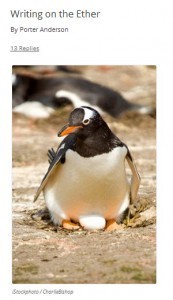 It was in November 2011 that I was Etherizing one Big Sixer’s bad call in Reverse Penguin!
It was in November 2011 that I was Etherizing one Big Sixer’s bad call in Reverse Penguin!
Look! Over at your library! It’s a bunch of short guys in tuxedos running away with the ebooks! Not the existing ebooks, the new ebooks. (Nothing is simple, remember, and the dew is on the decimal.)
That was the Thanksgiving Surprise when our friends at Penguin told off OverDrive (the big distributor of ebooks to libraries) and ordered it to suspend providing Penguin ebooks to libraries.
gah, i’m going to have to make fried chicken this weekend, aren’t i?
[image error]April 29, 2013 11:11 pm via Tweetbot for MacReplyRetweetFavorite
Kassia Krozser
From there, things got worse. Questions about the future viability of libraries rose on all sides. Real estate people were driving past libraries thinking parking structures…department stores…office buildings. You could almost smell the smoke from Alexandria, papyrus goes up so fast.

Mike Shatzkin
As recently as this past November (a year after Penguin put OverDrive into the nether gear), MIke Shatzkin in Much-trumpeted survey proves the opposite of what the surveyors seem to think it does explained the publishing camp’s reticence.
He was following a survey put together by OverDrive and the Library Association, the results of which, as he wrote, “are interpreted as evidence that the big publishers are making a terrible mistake being cautious about making ebooks available for library lending.” He pictured what is usually touted as library patrons’ eagerness to buy books as something that turns up only when those books aren’t available for a free read at the nearest temple of learning:
What if the book purchasers among the library ebook borrowers…(are) buying some ebooks because those aren’t available in the library? So I’d say “thanks for the information” and for evidence from an unbiased source that publishers are entirely correct to be wary and careful about making ebooks available for library lending.
WHY IS EVERYONE TRYING TO SCHEDULE A MEETING WITH ME ON MAY 30TH? WHAT’S WRONG WITH THE 29TH?
[image error]about 15 hours ago via SeesmicReplyRetweetFavorite
Ginger Clark
Well, things have changed considerably. Maybe those, “Hey, would you like to buy this book instead of checking it out?” buttons some libraries have experimented with have heartened publishers. Because all the bigs now have something cooking in the reading room.
Does anyone else find it weird when students write you to interview you about your work instead of reading it?
[image error]about 1 hour ago via webReplyRetweetFavorite
Gabriella Coleman
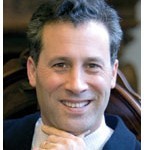 In his op-ed piece in the Times, E-Books and Democracy, New York Public Library president Anthony W. Marx summarizes where we are in this long-unhappy dance of the libraries and major publishers on ebooks.
In his op-ed piece in the Times, E-Books and Democracy, New York Public Library president Anthony W. Marx summarizes where we are in this long-unhappy dance of the libraries and major publishers on ebooks.
Last September, Penguin agreed to make its e-books available to patrons at the New York Public Library and the Brooklyn Public Library, but with a six-month lag for new titles. Penguin recently agreed to release e-books to libraries at the same time its hardcovers came out. In April, Simon & Schuster agreed to sell e-books to the city’s libraries. Today’s announcement by Hachette (whose imprints include Little, Brown) is the capstone of that process.
Many issues still need to be sorted out. Five of the Big Six are making their entire e-book inventory available to us to choose from, while Macmillan is offering only a limited selection. HarperCollins allows us to lend each e-book we acquire only 26 times per title; Penguin and Simon & Schuster offer one-year licenses; and Random House sells licenses without time limits but charges much more per license. (In all cases, an e-book can be borrowed by only one patron at a time.) Prices charged to libraries vary widely according to the kind of license agreement, and we hope they will be reduced as demand increases.
All other rejection letters can now retire: twitter.com/LettersOfNote/…
— Shaun Usher (@LettersOfNote) April 30, 2013
I warn you now, I will probably tweet that rejection letter every day for the rest of my life. Beedle-de-bo-bo!
[image error]April 30, 2013 11:50 am via TweetDeckReplyRetweetFavorite
Shaun Usher
[image error]
Laura Hazard Owen
There’s also an easier-to-follow assessment of where we are now from Laura Hazard Owen, in her announcement story at paidContent, Following pilot, Hachette will make all of its ebooks available to libraries nationwide. Here is is, bulleted (no extra charge):
The last couple of months have brought many changes to Big 6 publishers’ ebook lending policies, with Penguin and Simon & Schuster both announcing changes to their programs.
Penguin announced in March that it would begin making new ebooks available to libraries again, a year after it had pulled them, though it is still only working with a limited number of libraries in a pilot program.
Simon & Schuster is making its ebooks available to New York City public libraries in a trial.
Random House makes all of its ebooks available to libraries, but at prices as much as three times higher than the retail price.
HarperCollins allows its ebooks to be checked out 26 times before the library has to buy a new copy.
Macmillan is running a two-year trial that makes 1,200 older ebooks available to libraries.
*says with tears in her eyes* I love chips so so much.
[image error]April 30, 2013 10:59 pm via Tweetbot for iOSReplyRetweetFavorite
Ellie Ann
That’s a lot of action, really, in a space that has at times looked all but deadlocked. And although we tend to look at libraries through a golden haze of childhood-happy memories, I’m not sure anybody in this whole part of the digital publishing saga has looked great all the time.

Barbara A. Genco
I recall Barbara Genco of the Library Journal a couple of TOCs ago chortling to the audience in New York that “friction is fiction.” At the time, one of the publishers’ complaints was that library access to ebooks might be too easy, compared to borrowing physical books—there wasn’t enough “friction” in the process of checking out an ebook.
There was another bump along the way when it seemed that publishers hadn’t known that OverDrive’s fulfillment process for ebooks checked out from libraries involved Amazon. Oops, who ate the data?
Ow. I suck at this.
[image error]April 29, 2013 8:56 pm via Twitter for AndroidReplyRetweetFavorite
Blaine
Owen, in her new story, points out that OverDrive is again in the picture with Hachette’s deal:
Hachette is working with all three major library distributors: Overdrive, Baker & Taylor and 3M. Because Hachette is working with Overdrive, this means that the ebooks will be available for Kindle.
We should hear more about this late this month at the Digital Book Conference at BEA, OverDrive president Steve Potash is on the bill.
Meanwhile, pricing.
You keep using the word “open”. It does not mean what you think it means.
[image error]April 30, 2013 2:22 pm via TweetDeckReplyRetweetFavorite
ljndawson
Free Would be Nicer
On first hearing, the idea of a library having to pay three times the price of the “primary” print book for a just-released ebook might sound like a raw deal.
I wonder if publishers will become nervous to acquire autobiographies of “national treasures from the 70s”?
[image error]about 2 hours ago via webReplyRetweetFavorite
jonny geller
Owen clarifies, “Hachette defines ‘primary’ book price as ‘the highest-price edition then in print.’” And she notes that if a library waits a year after an ebook’s publication, Hachette drops its price to 1.5 times that “primary” print book.
But get this: unlimited checkouts. Did you think we’d ever hear that phrase?
What’s more, a library does not have to buy a new copy of a Hachette ebook after a year, Owen writes. A highly popular ebook with a waiting list will outlast the print edition, which takes wear and tear on its checkouts.
OMG A MUSICIAN ON MY FLIGHT WITH A KENNY G BRAND INSTRUMENT CASE.
[image error]about 18 hours ago via Twitter for AndroidReplyRetweetFavorite
Matt Marks
 The concept of compromise behind this pricing is described in the Associated Press writeup by Hilel Italie this way, here in the Miami Herald’s run of the wire, Hachette Book Group expands library e-catalog:
The concept of compromise behind this pricing is described in the Associated Press writeup by Hilel Italie this way, here in the Miami Herald’s run of the wire, Hachette Book Group expands library e-catalog:
As with other publishers, Hachette is seeking a balance by offering a comprehensive list of e-books, but not unlimited, or cheap, e-book service. For new releases, only one e-book can be borrowed at a time. And libraries, many of which operate under tight budgets, will be charged three times the highest priced print edition for one year of e-book access to a new publication.
Before you throw the Ether across the room about “only one ebook can be borrowed at a time,” remember that only one print copy of a book can be borrowed at a time.
@editorius @infinite_if But if 8th Doctor is canon, his mum is not a Time Lord. Moffat may have decided Claire Bloom was someone else…
— Dave Morris (@MirabilisDave) May 1, 2013
And while a purist among the digirati will argue that the e-world should not be forced to match the analog world, at this stage in the game, the more closely ebook procedures can reflect print book procedures, the more progress is likely to be made in these early days of disruptive unease between your local library and your New York publisher. And for signs of such progress? Listen up. Some may say they’re tokens but at least nods to the author are there to be heard.  The Bookseller, in its report, Hachette US to make new e-books available to libraries, quotes the publisher’s CEO Michael Pietsch in his statement:
The Bookseller, in its report, Hachette US to make new e-books available to libraries, quotes the publisher’s CEO Michael Pietsch in his statement:
“I grew up in public libraries and appreciate deeply their importance to readers hungry for more. Hachette Book Group believes strongly in supporting the availability of books in all formats to library users, in ways that recognize the importance and value of authors’ works.”
OH MY GOD CHANNEL TWO NEWS THERE IS NO SUCH THING AS THE QUARTER LIFE CRISIS FER FUCK’S SAKE IT’S CALLED GROWING UP!!!!!!!!!!
[image error]April 29, 2013 11:17 pm via webReplyRetweetFavorite
Colleen Lindsay
@
[image error]April 29, 2013 11:17 pm via Tweetbot for iOSReplyRetweetFavorite
Natalie L.
So What’s Up With eBooks, Anyway?
In library terms?

Gillian Tett
The ever-resourceful Gary Price at InfoDocket (a publication of Library Journal) offers a couple of figures from a Financial Times article in February. In Are library books on borrowed time? Gillian Tett wrote:
Since 2009, the NYPL has quadrupled its budget for ebooks, and spent $1m on 45,000 ebook copies. Indeed, [Anthony] Marx envisages his library as being akin to a giant cyber educational hub, offering anyone access, anywhere in the world, however poor. “We need to be the leading educational programme, cradle to grave,” he says.
Tennessee — there ain’t no place I’d rather be!
[image error]April 29, 2013 11:53 pm via webReplyRetweetFavorite
Jeremy Greenfield
But, as ever, our publishing pundits are quick to turn up with their predictions. And the latest, as written up by the Digital Book World staff in Codex Group: Ebooks to Level Off at 30% of Publishing Revenues, With Caveats, is the perpetually predictive Peter Hildick-Smith of the oracular Codex Group.

Peter Hildick-Smith
Hildick-Smith has been summoned to Nashville to address the Evangelical Christian Publishers Association Leadership Summit. And, as DBW puts it together, he has told the assembly gathered on that mountaintop that “50 percent (of all U.S. book publishing revenues being ebooks) just doesn’t seem doable based on usage dynamics and reader statistics.” No, Hildick-Smith says, “It will be 29 percent in 2014 and 30-to-70 percent will be the persistent level.”
L’amore bugiardo (Gone Girl) by G. Flynn most sold #ebook 1q2013 in Italy by RCS under #RizzoliFirst (digital first imprint) @
[image error]about 2 hours ago via Twitter for iPhoneReplyRetweetFavorite
Marcello VENA
That 30-percent figure is a bit shallow for folks who have expected a slowly but steady advance for ebooks toward the 50-percent mark. And even Hildick-Smith seems shy of full bravado on this one, coming in with three caveats, as laid out by DBW. Starting with a “stable physical retail environment,” these don’t really arrive as features of the likeliest sounding scenarios.
1. Stable physical retail environment: If Barnes & Noble collapses or shelf space continues to decline, the percentage of revenues from ebooks could increase. 2. Book prices don’t collapse: Ebook prices for many of the best-selling books continue to fall. If book “anchor prices” (what consumers generally expect to pay) for ebooks decrease enough, ebooks could grow past 30 percent. 3. Independent authors don’t experience exponential growth over the next few years: If indie authors take away enough business from retail bookstores and at relatively lower price points, it could accelerate both caveats one and two.
More prayer may be needed in Nashville.
Insane caveats RT @: Codex group: Ebooks to level off at 30% of all book publishing revenues (w caveats) http://t.co/RQmEAhTYTp
[image error]about 6 hours ago via Twitter for iPhoneReplyRetweetFavorite
Sam Missingham
 
So let me be the first to declare that we will see more ebook growth pretty much everywhere. #Yep #Scientific
[image error]about 6 hours ago via Twitter for iPhoneReplyRetweetFavorite
Sam Missingham
 For now, the Pew Internet wing of Pew Research Center is rallying the faithful with a dance around its May poll of parental types on the topic of libraries, and—no surprise—the warm-and-fuzzy saints are marching in, chanting “Don’t Touch Our Libraries, Damn It.” You can see the full report in this PDF from Pew. Its summary story is here, Parents, Children, Libraries, and Reading. I’ll give you a few highlights from the report:
For now, the Pew Internet wing of Pew Research Center is rallying the faithful with a dance around its May poll of parental types on the topic of libraries, and—no surprise—the warm-and-fuzzy saints are marching in, chanting “Don’t Touch Our Libraries, Damn It.” You can see the full report in this PDF from Pew. Its summary story is here, Parents, Children, Libraries, and Reading. I’ll give you a few highlights from the report:
Parents are more likely than other adults to think libraries should definitely offer a broader selection of e-books (62% vs. 49%) and definitely offer more interactive learning experiences (54% vs. 43%).
Parents express more interest than other adults in an array of tech-oriented services that are being discussed and implemented among some American libraries, including online reference services, cell phone apps to connect to library materials, tech “petting zoos” that would allow people to try out new gadgets, and library kiosks or “Redbox”-type offerings in the community to check out books and movies.
It’s kind of cool living in the early days of a Golden Age of Humankind.
[image error]about 5 hours ago via TweetDeckReplyRetweetFavorite
Damien Walter
In this graphic, you’ll note that parents surveyed by Pew for this report were more likely than “other adults”—I think that’s us godless adults who aren’t rearing the next generation—to support “ebook readers already loaded with books you want to read.” As opposed to books you don’t want to read, I suppose. Also, they liked “classes on how to download library ebooks.” And “instruction on how to use ebook reading devices.”
The analysts I know that don’t really care about apps tend to have pretty ugly blogs. A correlation there, perhaps.
[image error]about 2 hours ago via Twitterrific for MacReplyRetweetFavorite
Benedict Evans
Maybe the scariest bit? Seventy percent of the moms and pops responding said they’d support “digital media lab(s) to create/upload new content like movies or ebooks.” You know what this means, right? They’re writing books. More books. God help us.
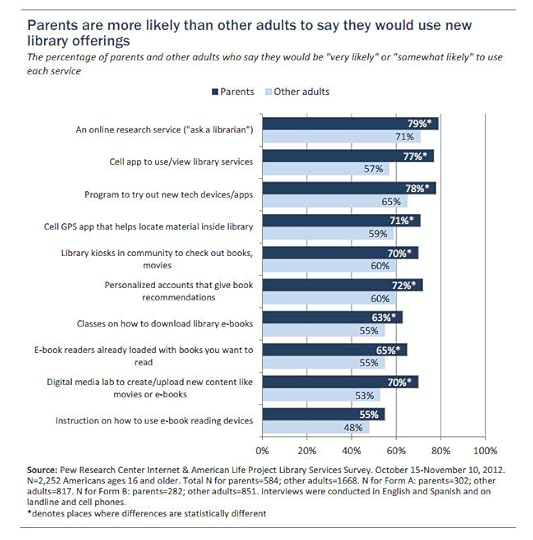
PewInternet.org / Pew Research Center
That gender divide so few seem to want to talk about is present in this context, too.
Mothers are more likely than fathers to say libraries are important to their communities (94% vs. 87%). And they are more likely than fathers to say libraries are important to them and their families (87% vs. 80%).
When it comes to their own children, mothers are more likely than fathers to say a major reason why libraries are important is because libraries help children develop a love of reading and books (90% vs. 77%). Mothers also are more likely to believe libraries offer their children access to information and resources they can’t get at home or school (86% vs. 75%).
Mothers say they are better informed than fathers about what their local library offers: 32% of mothers say they are know all or most of the services and programs the library offers, compared with 21% of fathers.
This tweet is funny because my mother is a journalist: twitter.com/nntaleb/status…

— Baldur Bjarnason (@fakebaldur) May 2, 2013
If we’re to extrapolate from Pew’s findings, it’s hard not to think that we’re being told that the coveted family market during the reading-encouragement years of parenting is right there at the library where it’s probably been all along.
So even if the reception of the Hachettte news is a bit tepid in this chilly spring—and even if Hildick-Smith is having a crisis of faith in the coming triumph of ebooks—publishers can hardly seem to go wrong to look at libraries as the place to throw a little digital largess.
As the ribbons wind ’round us, the parents are telling us that blessed will be the ties that bind corporate interests to more community cooperation.
Let me know what you think — would you have expected parents today to see the library as a key component of technical experience for their kids? And is this something publishers can capitalize on in deepening relationships with libraries?
https://twitter.com/DwightGarner/stat...
Main image / iStockphoto: Sarradet
Penguin image / iStockphoto: Charlie Bishop
The post WRITING ON THE ETHER: Springtime for Librarians appeared first on Jane Friedman.
April 26, 2013
What One Small Step Made a Big Impact on Your Writing Career?
The biggest career-changing moves I ever made were a combination of:
Signing up for Twitter in 2008 & starting the Best Tweets for Writers series (story here)
Buying my own domain name—long before I ever started using it—in 2005, then actually launching this site in December 2009
What have your career-changing moves been? Writer’s Digest is asking writers to share the small steps they took or decisions they made that at the time maybe didn’t seem that significant, but have made a substantial and positive impact on their writing/publishing careers.
For more details—and to possibly end up making a contribution to the magazine—visit this Writer’s Digest post.
The post What One Small Step Made a Big Impact on Your Writing Career? appeared first on Jane Friedman.
Jane Friedman
- Jane Friedman's profile
- 1882 followers



